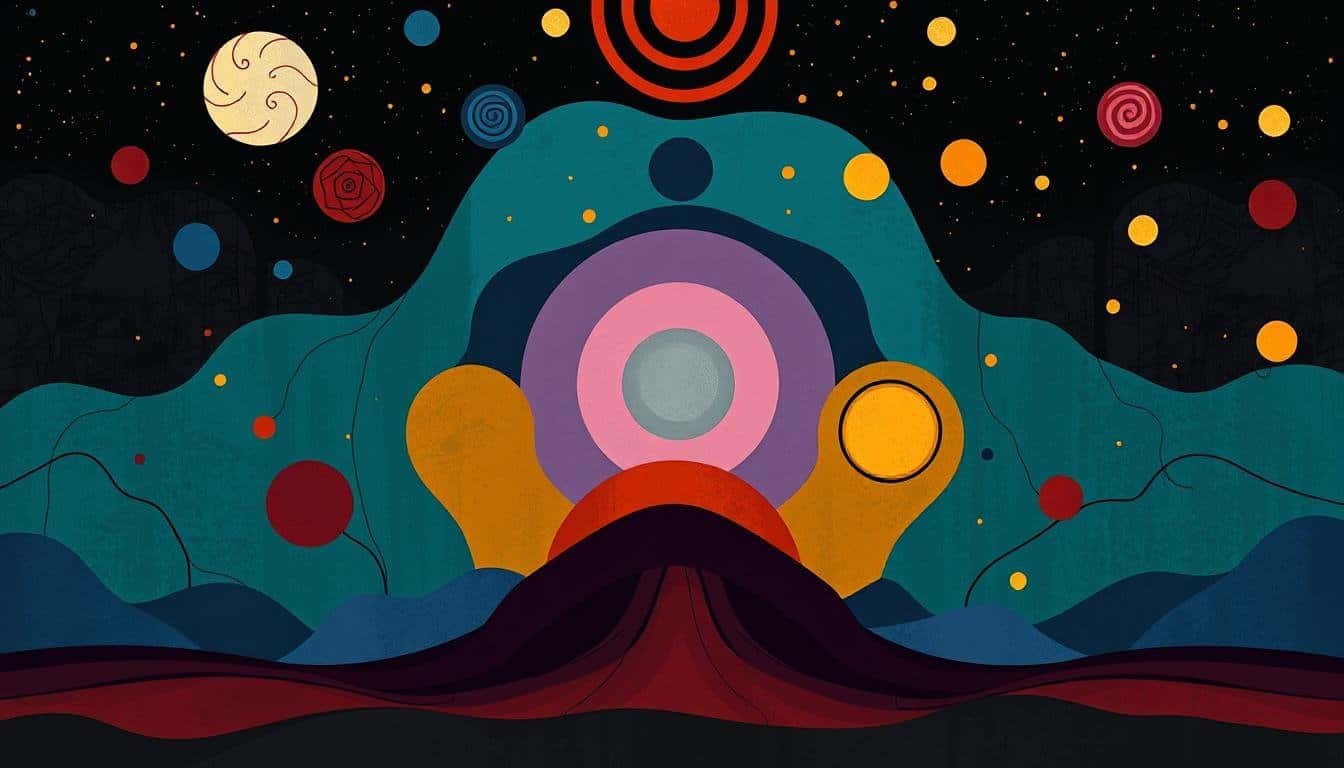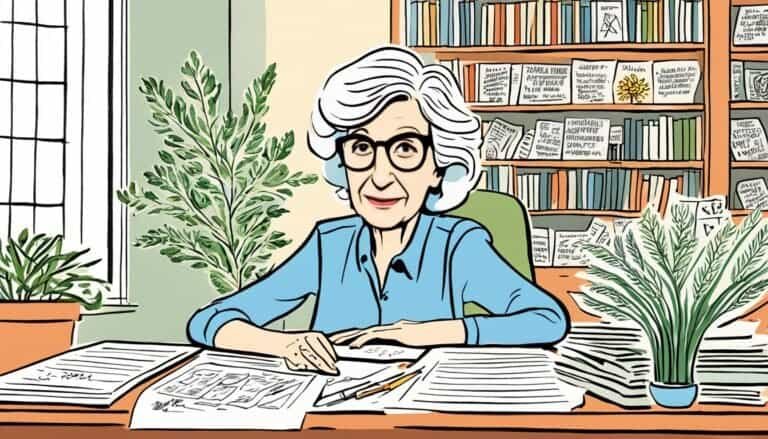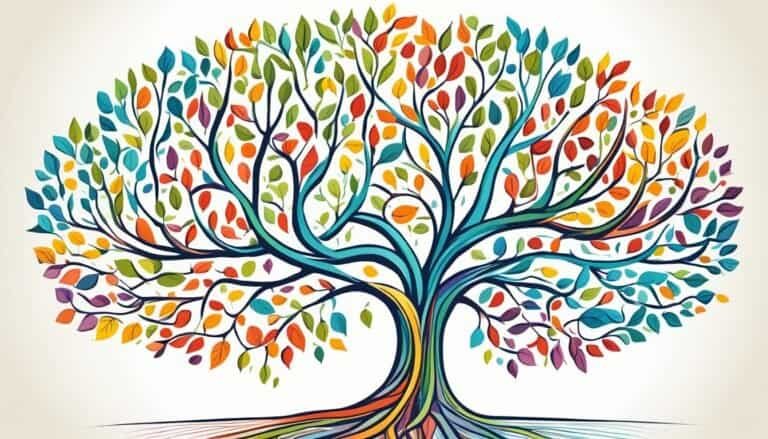Carl Jung: The Collective Unconscious and Individuation
“The meeting of two personalities is like the contact of two chemical substances: if there is any reaction, both are transformed.” – Carl Jung
Carl Jung, a Swiss psychiatrist, changed how we see the human mind. His ideas about the collective unconscious and becoming one’s true self are still important today.
Jung believed in a collective unconscious, a part of our minds that shares experiences from our ancestors. This idea helps explain why we all share certain thoughts and behaviors.
He also talked about individuation, the journey to find our true selves. It’s about bringing together our conscious and hidden thoughts to live more fully.
Let’s dive into Jung’s theories and see how they help us understand ourselves and grow. His work on archetypes and dreams gives us a peek into our deep inner world.
Introduction to Carl Jung’s Psychological Theories
Carl Jung was born in 1875 and made big steps in analytical psychology. His work at the Burghölzli Hospital made him look into the human mind. He noticed common themes in patients’ dreams and delusions. This led him to believe in a shared unconscious mind.
Jung’s Background and Influence
Jung started his psychology journey with a letter to Sigmund Freud in 1906. This started a seven-year collaboration that ended with a split. Jung studied world myths and found similar images across cultures. This supported his idea of a shared unconscious mind.
Key Concepts in Jungian Psychology
Jung believed in layers in the unconscious mind. He talked about a personal unconscious and a collective one inherited from our ancestors. Archetypes, or universal patterns, are key in Jungian psychology.
| Archetype | Description | Role in Psyche |
|---|---|---|
| Persona | Social mask | Adaptation to society |
| Shadow | Dark side of personality | Repressed desires and instincts |
| Anima/Animus | Feminine/Masculine aspects | Psychological development |
| Self | Center of psyche | Unity and wholeness |
Divergence from Freudian Psychoanalysis
Jung’s ideas were different from Freud’s on the unconscious mind. While Freud looked at personal experiences, Jung saw a shared part of the psyche. This view led to the creation of analytical psychology as its own field.
The Concept of the Collective Unconscious
Carl Jung first talked about the collective unconscious in 1916. It’s a shared part of our minds that holds common, inherited thoughts and instincts. These symbols and patterns are found in everyone.
This shared unconscious affects our deep beliefs and actions. It touches on spirituality, how we act sexually, and our views on life and death. Jung found important archetypes like the Anima, Animus, Hero, and Shadow in it.
Studies say our inherited unconscious might be why we fear certain things. For instance, fears of the dark or loud noises might come from our collective mind. Dreams help us tap into this hidden part of us, showing us parts of our minds we haven’t fully explored.
“The collective unconscious contains the whole spiritual heritage of mankind’s evolution born anew in the brain structure of every individual.” – Carl Jung
There’s still debate on whether the collective unconscious is real or just symbolic. But its effect on how we act is still being studied. Researchers are looking into how it affects social media use and even our gut health.
Jung’s idea of the collective unconscious helps us understand human psychology better. It shows us the common symbols and patterns that shape our thoughts, feelings, and actions. These patterns cross cultures and time.
Archetypes: The Building Blocks of the Collective Unconscious
Carl Jung’s theory is built on archetypes, which are deep patterns in our minds. They shape how we see the world and act, no matter where we’re from. Jung saw our minds as having three parts: the conscious, personal unconscious, and collective unconscious.
Definition and Significance of Archetypes
Archetypes are like blueprints for our minds. They are patterns that come from our ancestors and shape our thoughts and actions. These symbols are important because they help us understand ourselves and the world.
Common Archetypes in Jungian Theory
Jung found many important archetypes, including:
- The Persona: Our social mask
- The Shadow: Our repressed traits
- The Anima/Animus: Our inner feminine/masculine
- The Self: The unified center of our psyche
- The Hero: Symbolizing life’s journey and transformation
These archetypes, along with others like the mother and trickster, help us understand symbols and stories in Jungian psychology.
The Role of Archetypes in Human Behavior
Archetypes deeply affect how we act and connect with others. They show up in dreams, art, and stories from around the world. This idea helps us see why different cultures share similar myths and legends. Knowing about archetypes can help us grow and understand ourselves better, leading to a more whole life.
Carl Jung: The Collective Unconscious and Individuation
Carl Jung’s ideas about the collective unconscious and individuation are key to his theories. They help us understand how we grow and realize ourselves. Jung saw individuation as a journey that starts in mid-life.
Individuation means blending our conscious and unconscious minds. It’s about finding a balance between our personal stories and the shared human experiences. This path helps us find who we truly are and our place in the world.
“The privilege of a lifetime is to become who you truly are.” – Carl Jung
Jung thought that not fully completing this journey could lead to neurosis. To realize ourselves, we must look into our dreams, explore archetypes, and solve deep inner conflicts. This path is tough but crucial for becoming whole.
| Aspect of Individuation | Description |
|---|---|
| Self-integration | Merging conscious and unconscious aspects |
| Archetypal dynamics | Exploring universal patterns in psyche |
| Symbolic imagery | Interpreting dreams and personal symbols |
| Transcendence | Moving beyond ego-centered perspective |
Jung’s work still inspires those looking for personal growth and self-realization. His theories give deep insights into our minds. They guide us on our unique paths to wholeness and happiness.
The Process of Individuation
Individuation is a journey of self-discovery and growth, as Carl Jung explained. It means bringing hidden parts of ourselves to the surface. This helps us understand ourselves better and grow personally.
Stages of Individuation
The process of individuation has several important stages:
- Confronting the Shadow: Recognizing and integrating repressed aspects of oneself
- Balancing Anima/Animus: Harmonizing masculine and feminine energies within
- Exploring Archetypes: Understanding universal patterns that shape behavior
- Integrating the Self: Achieving a sense of wholeness and authenticity
The Role of the Self in Individuation
The Self guides us in individuation. It’s the whole of our psyche, including both our conscious and unconscious parts. As we discover ourselves, we get closer to our true Self. This leads to better integration and growth.
Challenges in the Individuation Process
Individuation faces many challenges. These include:
- Resistance to change and self-reflection
- Difficulty accepting shadow aspects
- Societal pressures conflicting with personal growth
- Balancing individual needs with collective expectations
Overcoming these challenges needs commitment to exploring ourselves. We must be open to all parts of who we are. This leads to deeper self-awareness and a more meaningful life.
The Relationship Between the Collective Unconscious and Individuation
The collective unconscious is key to finding ourselves. It’s a deep part of our mind filled with universal patterns and symbols. These guide our growth and help us blend our unique stories with shared experiences.
Psychological integration means balancing our shared and personal experiences. Jung said ignoring either could cause imbalance. To become whole, we must accept and use archetypal influences in our lives.
Archetypes, from the collective unconscious, guide us towards wholeness. They shape our actions, thoughts, and feelings. Recognizing and using these archetypes helps us understand ourselves and others better.
“The goal of individuation is the gradual development of a unified, integrated personality that resolves conflicts between introverted and extraverted tendencies.”
Self-realization means facing both our personal and shared inner selves. This process brings balance between our conscious and unconscious minds. It leads to a truer, more complete identity. By using the collective unconscious, we can reach our full potential and live more fully.
Jung’s Approach to Dream Analysis and Symbolism
Carl Jung changed how we see the unconscious mind through his dream work. His ideas on dream analysis and symbolism give us deep insights into our minds.
The Importance of Dreams in Jungian Psychology
Jung saw dreams as a way to peek into our collective unconscious. He looked at over 80,000 dreams, sorting them into two types. These were big dreams from the collective unconscious and personal dreams from our own unconscious.
Interpreting Symbols in Dreams
Jung thought dream symbols were universal, showing archetypal patterns. He believed dreams were personal and needed to know the dreamer to understand them. Unlike Freud, Jung saw dreams as a way to balance our psyche.
Dream Analysis as a Tool for Individuation
Dream analysis was key in Jungian therapy for exploring the unconscious and helping with individuation. Jung gave nine rules for interpreting dreams, like treating them as facts and accepting their complexity.
| Dream Type | Origin | Purpose |
|---|---|---|
| Big Dreams | Collective Unconscious | Offer universal truths, catalyze personal growth |
| Compensatory Dreams | Personal Unconscious | Correct imbalances, highlight overlooked aspects |
Jung’s dream interpretation still shapes modern psychology. It gives us tools for understanding symbols and exploring the unconscious in therapy and personal growth.
Applications of Jung’s Theories in Modern Psychology
Carl Jung’s theories still shape modern psychology and psychotherapy. His ideas are used in many areas, not just traditional analytical psychology. Jung’s work is seen in marketing, literature, and cultural studies.
Jungian analysis is a unique type of psychotherapy. It looks at the unconscious through dreams, imagination, and symbols. This method helps people with anxiety, depression, addiction, and trauma.
Now, researchers link Jung’s theories with neuroscience. They study how the gut microbiome affects our unconscious actions. This area combines Jung’s psychology with new biology discoveries.
Jung’s ideas help us understand social media and culture. The collective unconscious and archetypes help us analyze online behavior and global trends.
“Jung’s analytical psychology represents a departure from the prevailing schools of thought in his era.”
The Myers-Briggs Type Indicator (MBTI) personality test comes from Jung’s work on psychological types. This shows how his ideas are still used today.
| Field | Application of Jung’s Theories |
|---|---|
| Psychotherapy | Dream analysis, symbolic interpretation |
| Marketing | Archetypes in brand positioning |
| Literature | Character development, narrative analysis |
| Cultural Studies | Understanding collective behaviors, trends |
Criticisms and Controversies Surrounding Jung’s Ideas
Carl Jung’s theories have sparked both interest and debate in the field of psychology. His ideas have shaped many minds, but they’ve also faced a lot of criticism. The idea of the collective unconscious, brought up in 1916, is a big point of contention. This is because there’s not enough proof that it exists.
Scientific Validity of the Collective Unconscious
Many say Jung’s theories, like the collective unconscious and archetypes, are hard to back up with science. The idea that we’re born with certain cultural symbols is hard to prove, leading to doubt. Yet, some research hints that our actions might be shaped by things we share unconsciously. This could be why people often act in ways that fit in with their groups.
Debates on the Universality of Archetypes
There’s a big debate over whether archetypes are the same everywhere. Jung pointed out archetypes like the Persona, Anima, and Shadow. But, some wonder if these fit all cultures. Critics think Jung might have seen the world through a Eurocentric lens, making his ideas less universal.
Ethical Considerations in Jungian Analysis
There are ethical worries in Jungian analysis. For example, there’s a risk of over-reading symbols and the analyst’s impact on a patient’s view of themselves. Jungian psychology can be complex, making it hard for both experts and the public to understand. This raises questions about how useful it is in therapy. Still, Jung’s ideas keep sparking new research and fresh looks in light of today’s psychology.
Source Links
- Individuation and the Self – The SAP
- The Collective Unconscious – International Association of Analytical Psychology – IAAP
- Carl Gustav Jung’s Theory of Personality in Psychology
- Carl Jung – An Introduction to Jungian Psychology
- Which Jungian Archetype Are You?
- An Introduction and Brief Overview of Psychoanalysis
- How Carl Jung’s Collective Unconscious Is Tied to Dreams, Beliefs, and Phobias
- Collective unconscious
- Jung’s model of the psyche | Jung and the Ego – The SAP
- 12 Jungian Archetypes: The Foundation of Personality
- Carl Jung’s Archetypes
- The Individuation Process: Carl Jung’s 3 Stages to Wholeness
- Jungian Psychology: Unraveling the Unconscious Mind
- Jung and his Individuation Process
- Carl Jung – The Archetypes and the Collective Unconscious
- What is Individuation? Carl Jung and the Journey of Self
- Individuation
- What is the Collective Unconscious? – a Jungian Perspective
- What is Jungian Psychology?
- Jung on the Nature and Interpretation of Dreams: A Developmental Delineation with Cognitive Neuroscientific Responses
- Dreams In Jungian Psychology: The use of Dreams as an Instrument For Research, Diagnosis and Treatment of Social Phobia
- Carl Jung’s Secrets: Jungian Dream Analysis
- What is Jungian Psychology?
- Applying Jung’s Archetypes and Theory of the Collective Unconscious to Ovid’s Metamorphoses
- Jung’s Most Controversial Idea: What is the Collective Unconscious?
- 10 Major Criticisms of Jungian Psychology
- Carl Jung







